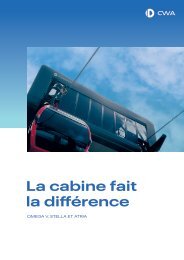Reversible Aerial Tramways [EN]
You also want an ePaper? Increase the reach of your titles
YUMPU automatically turns print PDFs into web optimized ePapers that Google loves.
<strong>Reversible</strong> <strong>Aerial</strong> <strong>Tramways</strong><br />
… to the unique.<br />
From the attractive …
2|3 <strong>Reversible</strong> <strong>Aerial</strong> <strong>Tramways</strong>
The king of aerial ropeways<br />
As a Doppelmayr/Garaventa customer, you benefit<br />
from leading-edge ropeway technology. We set the<br />
benchmark for transport systems geared to the future.<br />
Technology, innovation and performance have enabled<br />
us to win customer trust and made us the number one<br />
supplier in the world market. With our first aerial tramway<br />
installation in 1908 (Wetterhornaufzug, Grindelwald/<br />
Switzerland), Doppelmayr/Garaventa has over a century<br />
of experience.<br />
They are the ideal means of transport: <strong>Aerial</strong> tramways<br />
cross valleys, ravines, rivers and glaciers as well as<br />
any other rough terrain with ease; they also provide<br />
an impressive solution for urban transport. Rope spans<br />
can be as long as 3 km. While aerial tramways have<br />
long been a familiar sight in winter tourist resorts, they<br />
have also become an integral part of the public transport<br />
systems in cities and agglomerations, and represent<br />
an important marketing tool for ropeway operators.<br />
<strong>Aerial</strong> tramway experts<br />
for over 100 years
4|5 <strong>Reversible</strong> <strong>Aerial</strong> <strong>Tramways</strong><br />
The system in brief<br />
On a classic aerial tramway, one or two carriers, consisting<br />
of carriage, hanger and cabin, travel back and<br />
forth between the stations. They are propelled along<br />
one or two track ropes by means of a haul rope. The<br />
track ropes have fixed anchoring in one station, are<br />
guided on the line by means of saddles supported<br />
by towers, and in the opposite station are either fixed<br />
or tensioned by means of counterweights. The carriers,<br />
which travel along the track ropes, are connected to<br />
one another by means of the upper and lower haul<br />
rope. In one of the stations the haul rope is propelled<br />
by the drive system; in the other station it is loaded<br />
by means of a counterweight to achieve the necessary<br />
tension.<br />
In addition to the most frequently used configurations,<br />
Doppelmayr/Garaventa builds aerial tramways in special<br />
constructions. Specific customer requirements such<br />
as a single path of travel or winch drive as well as other<br />
design details can be accommodated without any<br />
problem. The transport capacity of an aerial tramway is<br />
between 500 and 2,000 passengers per hour, depending<br />
on the cabin size (from six to 200 passengers),<br />
travel speed (up to 12 m/s) and system length.<br />
Efficient and reliable
6|7 <strong>Reversible</strong> <strong>Aerial</strong> <strong>Tramways</strong>
The stations – well engineered<br />
through to every last corner<br />
Drive and return sheaves, gearbox, service and emergency<br />
brakes, couplings, primary, auxiliary and emergency<br />
drive, deflection sheaves, track and haul rope<br />
counterweights, track rope bollards – these are essential<br />
components housed in the two stations. Loading platforms<br />
that shift from side to side can also be incorporated<br />
to save space. This is precisely where the many<br />
years of experience and the know-how of Doppelmayr/<br />
Garaventa come into play. The optimal concept – including<br />
unconventional solutions – is developed and implemented<br />
in close collaboration with the customer<br />
and with in-depth knowledge of the applicable codes<br />
and standards (C<strong>EN</strong>, ANSI, EU Directive 2000/9/EC<br />
on cableway installations etc.).<br />
Highlights<br />
2004 78-ATW “Scenic Skyway”, Katoomba,<br />
Australia – transparent glass floor<br />
2006 78-ATW “Marquam Hill”, Portland,<br />
Oregon, USA<br />
2006 160-ATW “Ahornbahn”, Mayrhofen,<br />
Austria – Austria’s biggest aerial tramway<br />
with two 160-passenger cabins<br />
2008 100-ATW “Jackson Hole Tram”, Wyoming,<br />
USA – with integrated recovery concept<br />
(no need for rescue tram)<br />
2010 25-ATW “Halidzor - Tatev”, Yerevan,<br />
Armenia – world’s longest tramway in<br />
one section<br />
2012 “CabriO ® Kälti – Stanserhorn”,<br />
first CabriO ® tramway in Stans<br />
Stations to fulfill every aspiration –<br />
individual and remarkable
8|9 <strong>Reversible</strong> <strong>Aerial</strong> <strong>Tramways</strong><br />
Unmistakable and purpose-built<br />
The visual image of the aerial tramway is defined by<br />
the carriers – as a rule two, or in exceptional cases, just<br />
one. The cabins are available in a wide variety of designs<br />
and sizes to suit the exact needs of the customer.<br />
Welded steel plate hangers connect the cabins to the<br />
carriages. These carriages travel along the track ropes<br />
by means of their wheels (between six and 32 per carriage<br />
depending on the carrier size) and are fitted<br />
with track brakes where specified by the tram design.<br />
In the event of overspeed or a slack haul rope, the<br />
brakes are automatically engaged against the track<br />
ropes and bring the carriers to a safe stop. A major<br />
benefit of the reversible aerial tramway is its ability to<br />
transport cargo – whether in the cabins themselves<br />
or suspended underneath them.<br />
The cabin as showpiece
10|11 <strong>Reversible</strong> <strong>Aerial</strong> <strong>Tramways</strong><br />
Safety all along the line<br />
Ropeways, including aerial trams, rank amongst the<br />
safest means of transport in existence. This is due to<br />
extensive experience and the many safety devices<br />
used. Hydrostatic auxiliary or emergency drives ensure<br />
that the carriers can be safely brought back to<br />
the stations in the event of a failure, such as a power<br />
outage. If the tram is blocked, the passengers have<br />
to be evacuated from the cabins. This can be done<br />
using rope-down devices incorporated in the cabins.<br />
In good weather conditions it is also possible to bring<br />
the passengers to safety using a helicopter and rescue<br />
basket. In situations where the height above ground<br />
does not permit a rope-down evacuation, an independent<br />
rescue tram is deployed. The innovative recovery<br />
concept incorporating additional measures<br />
such as ‘redundant’ drives and readily available repair<br />
tools ensures that the carriers can return to the stations<br />
in the event of equipment malfunction.
Key features at a glance<br />
transport capacity up to 2,000 PPH<br />
rope spans of up to 3 km possible<br />
suitable for use in difficult terrain<br />
high operational efficiency through combined<br />
transport of passengers and freight<br />
attractive visual appearance with modern design<br />
and top-quality materials makes aerial trams<br />
an outstanding marketing tool<br />
ropeway system with enormous potential<br />
for the future
361/eng/gama/bbi/032013/1000<br />
Doppelmayr Seilbahnen GmbH<br />
Rickenbacherstraße 8–10, Postfach 20<br />
6922 Wolfurt / Austria<br />
T +43 5574 604, F +43 5574 75590<br />
dm@doppelmayr.com, www.doppelmayr.com<br />
Garaventa AG<br />
Tennmattstrasse 15<br />
6410 Goldau / Switzerland<br />
T +41 41 859 1111, F +41 41 859 1100<br />
contact@garaventa.com, www.garaventa.com


![Reversible Aerial Tramways [EN]](https://img.yumpu.com/56527570/1/500x640/reversible-aerial-tramways-en.jpg)

![Les téléphériques, moyen de transport urbain [FR]](https://img.yumpu.com/68664301/1/184x260/les-telepheriques-moyen-de-transport-urbain-fr.jpg?quality=85)
![Ropeways as a means of urban transport [EN]](https://img.yumpu.com/68664299/1/184x260/ropeways-as-a-means-of-urban-transport-en.jpg?quality=85)

![Seilbahnen als urbane Verkehrsmittel [DE]](https://img.yumpu.com/68664295/1/184x260/seilbahnen-als-urbane-verkehrsmittel-de.jpg?quality=85)
![CWA Pendelbahnkabinen, Standseilbahnfahrzeuge und Specials [DE]](https://img.yumpu.com/68646270/1/184x260/cwa-pendelbahnkabinen-standseilbahnfahrzeuge-und-specials-de.jpg?quality=85)
![CWA Aerial tramway cabins, funicular cars and specials [EN]](https://img.yumpu.com/68646268/1/184x260/cwa-aerial-tramway-cabins-funicular-cars-and-specials-en.jpg?quality=85)
![CWA Cabines de téléphériques va-et-vient, voitures de funiculaires et véhicules spéciaux [FR]](https://img.yumpu.com/68646263/1/184x260/cwa-cabines-de-telepheriques-va-et-vient-voitures-de-funiculaires-et-vehicules-speciaux-fr.jpg?quality=85)

![CWA Cabines [FR]](https://img.yumpu.com/68446423/1/184x260/cwa-cabines-fr.jpg?quality=85)

![UP Interalpin 01/2023 [TR]](https://img.yumpu.com/68086699/1/190x248/up-interalpin-01-2023-tr.jpg?quality=85)
![UP Interalpin 01/2023 [SL]](https://img.yumpu.com/68086572/1/190x248/up-interalpin-01-2023-sl.jpg?quality=85)
![UP Interalpin 01/2023 [PL]](https://img.yumpu.com/68086528/1/190x248/up-interalpin-01-2023-pl.jpg?quality=85)
![UP Interalpin 01/2023 [CN]](https://img.yumpu.com/68003609/1/190x248/up-interalpin-01-2023-cn.jpg?quality=85)